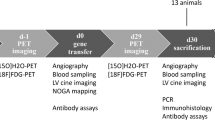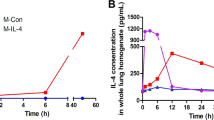Abstract
Interleukin-10 (IL-10) gene transfection of donor lungs prior to transplantation is an attractive strategy to reduce ischemia–reperfusion induced lung injury. However, experimental data with gene therapy in large animal models of lung transplantation are generally lacking. We have developed a simple clinically applicable technique for adenoviral-mediated gene delivery of human IL-10 to the lung of large animals that provides homogenous gene expression after 12–24 h of transfection. Using this technique of gene delivery, we have studied the dynamics of adenoviral gene delivery to the lung in the setting of lung transplantation. Although there is a persistent inflammatory response to the adenoviral vector, we achieved significant expression of human IL-10 in lung tissue before lung retrieval to obviate the deleterious impact of the adenoviral vector on the donor lung. The administration of adenoviral-mediated human IL-10 to the donor lung reduced ischemia–reperfusion injury and improved graft function after lung transplantation in this pig lung transplantation model. Transfection of adenoviral-mediated human IL-10 to the donor lung prevented the release of inflammatory cytokines such as IL-6 in lung tissue and plasma. We have demonstrated that IL-10 gene therapy has significant potential to prevent or treat the inflammatory response associated with ischemia–reperfusion injury in lung transplantation. In the future, IL-10 gene therapy could also be used for immunomodulation or tolerance induction.
This is a preview of subscription content, access via your institution
Access options
Subscribe to this journal
Receive 12 print issues and online access
$259.00 per year
only $21.58 per issue
Buy this article
- Purchase on Springer Link
- Instant access to full article PDF
Prices may be subject to local taxes which are calculated during checkout








Similar content being viewed by others
References
Hertz M et al. The registry of the international society for heart and lung transplantation: nineteenth official report – 2002. J Heart Lung Transplant 2002; 21: 950.
Fisher AJ, Dark JH, Corris PA . Improving donor lung evaluation: a new approach to increase organ supply for lung transplantation. Thorax 1998; 53: 818–820.
Pierre AF et al. Marginal donor lungs: a reassessment. J Thorac Cardiovasc Surg 2002; 123: 421–428.
Gabbay E et al. Maximizing the utilization of donor organs offered for lung transplantation. Am J Respir Crit Care Med 1999; 160: 265–271.
Bhorade SM, Vigneswaran W, McCabe MA, Garrity ER . Liberalization of donor criteria may expand the donor pool without adverse consequence in lung transplantation. J Heart Lung Transplant 2000; 19: 1199–1204.
Sundaresan S et al. Successful outcome of lung transplantation is not compromised by the use of marginal donor lungs. J Thorac Cardiovasc Surg 1995; 109: 1075–1079.
Fiser SM et al. Ischemia–reperfusion injury after lung transplantation increases risk of late bronchiolitis obliterans syndrome. Ann Thorac Surg 2002; 73: 1041–1047.
Waddell TK et al. Major histocompatibility complex expression and lung ischemia–reperfusion in rats. Ann Thorac Surg 1996; 62: 866–872.
De Perrot M, Liu M, Waddell TK, Keshavjee S . Ischemia–reperfusion-induced Lung Injury. Am J Respir Crit Care Med 2003; 167: 490–511.
Cassivi SD et al. Transplant immunosuppression increases and prolongs transgene expression following adenoviral-mediated transfection of rat lungs. J Heart Lung Transplant 2000; 19: 984–994.
Chapelier A et al. Gene therapy in lung transplantation: feasibility of ex vivo adenovirus-mediated gene transfer to the graft. Hum Gene Ther 1996; 7: 1837–1845.
Kanaan SA et al. Intratracheal adenovirus-mediated gene transfer is optimal in experimental lung transplantation. J Thorac Cardiovasc Surg 2002; 124: 1130–1136.
Cassivi SD et al. Transtracheal gene transfection of donor lungs prior to organ procurement increases transgene levels at reperfusion and following transplantation. J Heart Lung Transplant 1999; 18: 1181–1188.
De Perrot M et al. Interleukin-8 release during early reperfusion predicts graft function in human lung transplantation. Am J Respir Crit Care Med 2002; 165: 211–215.
Fisher AJ et al. Elevated levels of interleukin-8 in donor lungs is associated with early graft failure after lung transplantation. Am J Respir Crit Care Med 2001; 163: 259–265.
Fischer S et al. In vivo transtracheal adenovirus-mediated transfer of human interleukin-10 gene to donor lungs ameliorates ischemia–reperfusion injury and improves early posttransplant graft function in the rat. Hum Gene Ther 2001; 12: 1513–1526.
De Perrot M et al. Impact of early vector induced inflammation on the effect of adenoviral-mediated human interleukin-10 in lung transplantation. Am J Respir Cell Mol Biol 2003; 28: 616–625.
Itano H et al. Adenovirus-mediated gene transfer of human interleukin 10 ameliorates reperfusion injury of rat lung isografts. J Thorac Cardiovasc Surg 2000; 120: 947–956.
Eppinger MJ, Ward PA, Bolling SF, Deeb GM . Regulatory effects of interleukin-10 on lung ischemia–reperfusion injury. J Thorac Cardiovasc Surg 1996; 112: 1301–1305.
Gudmundsson G et al. Interleukin-10 modulates the severity of hypersensitivity pneumonitis in mice. Am J Respir Cell Mol Biol 1998; 19: 812–818.
Keshavjee S et al. The role of dextran 40 and potassium in extended hypothermic lung preservation for transplantation. J Thorac Cardiovasc Surg 1992; 103: 314–325.
Bradford MM . A rapid and sensitive method for the quantitation of microgram quantities of protein utilizing the principle of protein-dye binding. Anal Biochem 1976; 72: 248–254.
Le Moine O et al. Role of reactive oxygen intermediates in interleukin-10 release after cold liver ischemia and reperfusion in mice. Gastroenterology 1997; 113: 1701–1706.
Sousa DG et al. IL-1 driven endogenous IL-10 production protects against the systemic and local acute inflammatory response following intestinal reperfusion injury. J Immunol 2003; 170: 4759–4766.
Yang Z, Zingarelli B, Szabo C . Crucial role of endogenous interleukin-10 production in myocardial ischemia–reperfusion injury. Circulation 2000; 101: 1019–1026.
Frangogiannis NG et al. IL-10 is induced in the reperfused myocardium and may modulate the reaction to injury. J Immunol 2000; 165: 2798–2808.
De Perrot M et al. Recipient T cells mediate reperfusion injury after lung transplantation in the rat. J Immunol 2003; 171: 4995–5002.
Zwacka RM et al. CD4+ T-lymphocytes mediate ischemia/reperfusion-induced inflammatory responses in mouse liver. J Clin Invest 1997; 100: 279–289.
Yokota N, Burne-Taney M, Racusen L, Rabb H . Contrasting role for STAT4 and STAT6 signal transduction pathways in murine renal ischemia–reperfusion injury. Am J Physiol 2003; 285: F319–F325.
Asadullah K, Sterry W, Volk HD . Interleukin-10 therapy. Review of a new approach. Pharmacol Rev 2003; 55: 241–269.
Wood KJ, Sakaguchi S . Regulatory T cells in transplantation tolerance. Nat Rev Immunol 2003; 3: 199–210.
McDonald RJ et al. Safety of airway gene transfer with Ad2/CFTR2: aerosol administration in the nonhuman primate. Hum Gene Ther 1997; 8: 411–422.
Katkin JP, Husser RC, Langston C, Welty SE . Exogenous surfactant enhances the delivery of recombinant adenoviral vectors to the lung. Hum Gene Ther 1997; 8: 171–176.
Wilmott RW et al. Safety of adenovirus-mediated transfer of the human cystic fibrosis transmembrane conductance regulator cDNA to the lungs of nonhuman primates. Hum Gene Ther 1996; 7: 301–318.
Simon RH et al. Adenovirus-mediated transfer of the CFTR gene to lung of nonhuman primates: toxicity study. Hum Gene Ther 1993; 4: 771–780.
Lozier JN et al. Toxicity of a first-generation adenoviral vector in rhesus macaques. Hum Gene Ther 2002; 13: 113–124.
Benihoud K et al. The role of IL-6 in the inflammatory and humoral response to adenoviral vectors. J Gene Med 2000; 2: 194–203.
Ben Gary H et al. Systemic interleukin-6 responses following administration of adenovirus gene transfer vectors to humans by different routes. Mol Ther 2002; 6: 287–297.
Pham SM et al. Interleukin-6, a marker of preservation injury in clinical lung transplantation. J Heart Lung Transplant 1992; 11: 1017–1024.
Author information
Authors and Affiliations
Rights and permissions
About this article
Cite this article
Martins, S., de Perrot, M., Imai, Y. et al. Transbronchial administration of adenoviral-mediated interleukin-10 gene to the donor improves function in a pig lung transplant model. Gene Ther 11, 1786–1796 (2004). https://doi.org/10.1038/sj.gt.3302357
Received:
Accepted:
Published:
Issue Date:
DOI: https://doi.org/10.1038/sj.gt.3302357
Keywords
This article is cited by
-
Cytokines in Lung Transplantation
Lung (2022)
-
Endothelin receptor antagonist improves donor lung function in an ex vivo perfusion system
Journal of Biomedical Science (2020)
-
Pig lung transplant survival model
Nature Protocols (2018)
-
Ex Vivo Lung Perfusion
Current Transplantation Reports (2017)
-
Normothermic Ex Vivo Lung Perfusion in Clinical Lung Transplantation
Current Transplantation Reports (2015)



